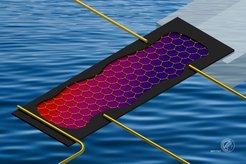Robustness of the thermal Hall effect close to half-quantization in α-RuCl3
The low-temperature thermal Hall effect reveals signatures of Majorana fermions in a field-induced spin liquid state.
One of the most exotic and sought-after phases of quantum matter is that of the quantum spin liquid, a magnetic state of matter in which strongly interacting local moments fluctuate and remain disordered down to absolute zero temperature. Unlike conventional magnetic states like ferromagnetism and antiferromagnetism, quantum spin liquids are very difficult to identify: they display no long-range magnetic order, no spontaneous time reversal or translational symmetry breaking and no sign of thermodynamic transitions or spin freezing. Their key property is their elementary excitations which, depending on the nature of the spin liquid, may be highly exotic quasiparticles such as "spinons", "visons", or "Majorana fermions". Positive identification of these excitations is the "smoking gun" proof of the quantum spin liquid ground state.

The search for quantum spin liquid materials has accelerated since the discovery of Kitaev quantum spin liquids, a class of systems with strong spin-orbit coupling and honeycomb-related crystal structures that have an exactly solvable ground state with Majorana fermion excitations. Prominent examples of these are H3LiIr2O6 (discovered in the Quantum Materials (Takagi) department in 2018) and α-RuCl3, both of which exhibit strong signatures of a low-temperature quantum spin liquid state. The challenge of detecting the charge-neutral Majorana fermions is considerable, but as they are mobile, they may contribute to thermal conductivity. Recently, a breakthrough came when it was found that the thermal Hall effect in α-RuCl3 reaches an approximately quantized plateau in a magnetic field of 8 tesla, at exactly half the amplitude shown by electrons in the famous quantum Hall effect. This was interpreted as evidence for Majorana fermions forming quantized edge states whilst carrying half of the entropy of an electron due to their fractionalized nature. However, the studies are so far limited to relatively high temperature (3 kelvin) and have been difficult to reproduce, so whether the ground state is truly a Kitaev quantum spin liquid is still under discussion.
In this work, Jan Bruin, Ralf Claus and Yosuke Matsumoto from the Quantum Materials (Takagi) department, using single crystals provided by Prof. Tanaka and Dr. Kurita from TIT in Japan, shine new light on the exotic ground state of α-RuCl3. They discovered a large thermal Hall effect close to the half-quantized value up to high magnetic fields and down to more than an order of magnitude lower in temperature than previously reported. This discovery gives extremely important clues in identifying the possible Majorana edge state. In addition, they unveiled a magnetic field-dependent structure of the low-temperature thermal conductivity that suggests the presence of high-field phase transitions, revealing a considerably richer phase diagram than previously known.











